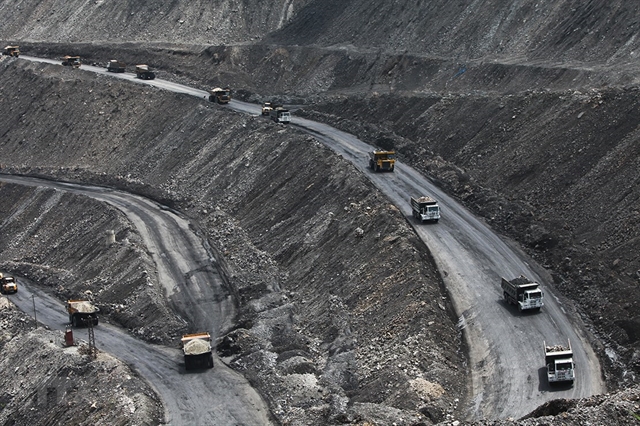 Economy
Economy


|
| A coal mine of Núi Béo Coal JSC in the northern province of Quảng Ninh. — VNA/VNS Photo Trọng Đạt |
HÀ NỘI — Although global coal prices have reached a record high, Vietnamese coal mining enterprises have still failed to increase revenue and profit, and some of them have even suffered losses.
According to the International Energy Agency (IEA), the world average coal price has reached the highest level in history with a year-on-year hike of 110 per cent in the past nine months of 2021 and surging 75 per cent compared to the beginning of the year, though the nine-month global coal demand only increased 4.5 per cent year-on-year, after falling 5 per cent in 2020.
However, experts from SSI Securities JSC (SSI) said that the coal price in Việt Nam was not in line with the global price due to the Government’s strict price management policy that allowed only two firms – Việt Nam Coal-Mineral Industries Holding Corp (Vinacomin) and the Quảng Ninh Province-based Đông Bắc Corporation – to mine and sell coal.
According to SSI, domestic coal prices were usually adjusted when there was a large increase in production costs. That only happened once every 3-4 years. In 2021, only the coal price for cement production was revised to increase by 9 per cent in August, while the coal price for thermal power remained unchanged to reduce pressure on Vietnam Electricity (EVN) when the Government was asking for electricity price support amid the pandemic.
As coal was mainly used for thermal power, accounting for 72 per cent of domestic demand, SSI estimated that this year's coal price would rise slightly by 4 per cent compared to 2021.
Meanwhile, Việt Nam had to import coal at an average price 83 per cent higher in the past nine months compared to the same period last year.
Coal production costs also increased due to the high global coal price while two domestic producers, Vinacomin and Đông Bắc Corp, had to import about 20-25 per cent of coal from Australia and Indonesia to mix with domestic coal in order to meet domestic demand. At the same time, the cost of fuel also increased sharply, making coal mining more expensive.
SSI said the coal industry was directly affected by the coal fever, but the coal price policy was strictly controlled by the Government, so most local coal mining enterprises had not benefited from the current high prices.
Vinacomin's total revenue in the nine-month period hit VNĐ94.6 trillion (US$4.11 billion), up 2.1 per cent year-on-year, VNĐ13.2 trillion of which had been added to the State budget.
During the period, the group produced 29.67 million tonnes of coal and sold 33.23 million tonnes, thus fulfilling 77-79 per cent of the yearly target, respectively.
In the first half of 2021, the total revenue and profit of listed coal mining enterprises reached VNĐ10.6 trillion, down 1.7 per cent and VNĐ115 billion, down 8.2 per cent respectively over the same period last year.
In H1, coal mining enterprises said they did not have prospects for increasing selling prices or boosting consumption.
Data from the Ministry of Industry and Trade (MoIT) showed Việt Nam would sharply increase imports of coal and gas to meet development needs from now to 2030.
The latest data from the ministry sent to the National Assembly showed the country was transitioning from an energy exporter to a net importer.
Notably, the import scale of coal and gas of the country is also growing along with increased spending to invest and buy fuel to serve the country's development.
The amount of imported coal increased sharply due to difficulties in domestic coal exploitation, especially the development of new mines, so coal output produced domestically was not enough to fuel thermal power plants.
According to the Oil, Gas and Coal Department under the MoIT, the country's energy import trend would continue to increase in the long term and energy import dependency ratio would be around 33-37 per cent by 2025 and up to 50-58 per cent by 2035. — VNS









